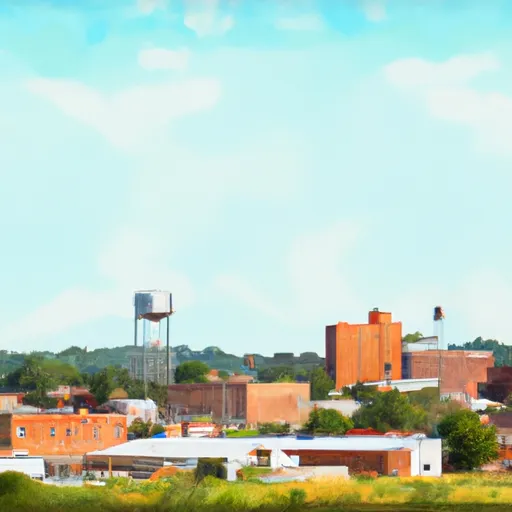-
 Snoflo Premium
Snoflo Premium
Get unlimited access to all our content
With no Ad interruptions! - Start Your Free Trial Login with existing account
Rudy
Eden Index
Climate
8.0
•
Recreation
6.6
•
Community
•
Safeguard
5.5/10

Rudy, Arkansas is a small town located in Crawford County, in the northwestern part of the state. The climate in Rudy is typically humid subtropical, characterized by hot, humid summers and mild, relatively cool winters. Average temperatures range from around 30°F (-1°C) in January to about 90°F (32°C) in July. The area receives an average annual rainfall of approximately 50 inches, with the wettest months being May and June.
Hydrologically, Rudy is situated in the Arkansas River basin, with several small creeks and tributaries running through the area. The Mulberry River, a popular destination for outdoor enthusiasts, is located just a short drive from Rudy. This river offers excellent opportunities for kayaking, canoeing, and fishing, as well as camping and hiking along its scenic banks.
In addition to the Mulberry River, Rudy and its surroundings provide numerous outdoor recreation opportunities. The nearby Ozark National Forest offers miles of trails for hiking, horseback riding, and mountain biking, allowing visitors to explore the beautiful natural surroundings. Hunting is also a popular activity in the area, with opportunities for deer, turkey, and small game hunting. Overall, Rudy, Arkansas is an ideal destination for those seeking to enjoy the beauty of nature and engage in various outdoor activities.
What is the Eden Index?
The Snoflo Eden Index serves as a comprehensive rating system for regions, evaluating their desirability through a holistic assessment of climate health, outdoor recreation opportunities, and natural disaster risk, acknowledging the profound impact of these factors on livability and well-being.
Climate Health Indicator (CHI): 8.0
Rudy receives approximately
1255mm of rain per year,
with humidity levels near 89%
and air temperatures averaging around
16°C.
Rudy has a plant hardyness factor of
7, meaning
plants and agriculture in this region tend to thrive during the non-winter months.
By considering the ideal temperature range, reliable water supplies, clean air, and stable seasonal rain or snowpacks, the Climate Health Indicator (CHI) underscores the significance of a healthy climate as the foundation for quality living.
A healthy climate is paramount for ensuring a high quality of life and livability in a region, fostering both physical well-being and environmental harmony. This can be characterized by ideal temperatures, reliable access to water supplies, clean air, and consistent seasonal rain or snowpacks.
Weather Forecast
Streamflow Conditions
Lower Arkansas-Fourche La Fave
Area Rivers
Lower Arkansas-Fourche La Fave
Snowpack Depths
Lower Arkansas-Fourche La Fave
Reservoir Storage Capacity
Lower Arkansas-Fourche La Fave
Groundwater Levels
Recreational Opportunity Index (ROI): 6.6
The Recreational Opportunity Index (ROI) recognizes the value of outdoor recreational options, such as parks, hiking trails, camping sites, and fishing spots, while acknowledging that climate plays a pivotal role in ensuring the comfort and consistency of these experiences.
Access to outdoor recreational opportunities, encompassing activities such as parks, hiking, camping, and fishing, is crucial for overall well-being, and the climate plays a pivotal role in enabling and enhancing these experiences, ensuring that individuals can engage in nature-based activities comfortably and consistently.
Camping Areas
| Campground | Campsites | Reservations | Toilets | Showers | Elevation |
|---|---|---|---|---|---|
| Hurricane Creek - Lake of the Pines | 23 | 226 ft | |||
| Buckhorn Creek - Lake Of The Pines | 60 | 283 ft | |||
| Jackson Creek Park - Lake Texarkana | None | 327 ft | |||
| Atlanta State Park | 60 | 286 ft | |||
| Kelly Creek Park - Lake Wright Patman | 80 | 252 ft | |||
| Cass County Park | 46 | 244 ft | |||
| Caddo Lake State Park | 28 | 281 ft | |||
| Thomas Lake Park Dispersed | None | 241 ft | |||
| Rocky Point - Wright Patman Lake | 125 | 259 ft | |||
| Malden Lake - Wright Pattman Lake | 39 | 259 ft |
Nearby Ski Areas
Catastrophe Safeguard Index (CSI):
The Catastrophe Safeguard Index (CSI) recognizes that natural disaster risk, encompassing floods, fires, hurricanes, and tornadoes, can drastically affect safety and the overall appeal of an area.
The level of natural disaster risk in a region significantly affects safety and the overall livability, with climate change amplifying these risks by potentially increasing the frequency and intensity of events like floods, fires, hurricanes, and tornadoes, thereby posing substantial challenges to community resilience and well-being.
Community Resilience Indicator (CRI):
The Community Resilience Indicator (CRI) recognizes that education, healthcare, and socioeconomics are crucial to the well-being of a region. The CRI acknowledges the profound impact of these elements on residents' overall quality of life. By evaluating educational resources, healthcare accessibility, and economic inclusivity, the index captures the essential aspects that contribute to a thriving community, fostering resident satisfaction, equity, and social cohesion.

